This is a Canon T50 35mm SLR film camera. It was the first in Canon’s T-series lineup which would be the last Canon SLRs to use the aging manual focus FD mount. The T50 was an entry level camera with full program mode auto exposure and almost no manual control. Focus was done manually, and you had to rewind the film yourself when a roll was finished, but otherwise all other operations of the camera were automatic. This model is far from a desirable model, but what it does, it does very well, and there are tons of them available in the used market for only a couple of dollars.
Film Type: 135 (35mm)
Lens Mount: Canon FD Breech Mount
Lenses: Canon 50mm f/1.8 + many others
Focus: Fixed SLR Prism
Shutter: Focal Plane Vertical Metal Blade
Speeds: 2 – 1/1000 seconds (fully automatic)
Exposure Meter: TTL Center Weighted CdS meter with Analog Needle Viewfinder Readout
Battery: 2 x AA 1.5v Alkaline
Flash Mount: Hotshoe
Manual: http://www.cameramanuals.org/canon_pdf/canon_t50.pdf
My Thoughts
This is my first Quick Review on the site in which I give my thoughts on cameras that I don’t have a lot to say about. Perhaps, its an uninteresting model, or very similar to another camera I’ve already reviewed, or maybe it’s one that’s so common and well known, there just isn’t much I could add that isn’t already out there.
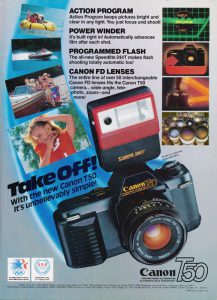
The Canon T-series doesn’t get much love out there. It followed the highly successful A-series, but preceded the very popular EOS series. It was the last in Canon’s line of SLRs that could accept the FD lens mount. With the release of the EOS 650 in 1987, Canon changed their lens mount to the newer EF mount which allowed for auto focus and a greater degree of communication between the lens and the body.
As a result, most of the T-series, with the exception of the high-spec T90, were delegated as entry level consumer level cameras. The T50 was the first in the series and debuted an all new plastic body which in my personal opinion is quite ugly. Perhaps bowing to the pressure of the public, or perhaps there was a need for batteries with more capacity, this was the first Canon SLR that used over the counter AA batteries. The battery compartment houses the batteries, but also functions as a hand grip which adds some level of convenience.
Although Canon had already been using plastic bodies since the AE1 from 1976, the T50 makes no attempt to look like chrome. Its not even black, its more of a muted grayish color. The additional size for the battery compartment widens the body about half an inch compared to the A-series.
Cosmetics aside, this is also a very basic camera. Every attempt was made to simplify the operation of this camera. Other than manual focus, everything else is handled by the camera. This is one of the first Canon SLRs to offer an automatic film advance. Each time the shutter release is pressed, the camera makes a very loud motorized sound as the film is being wound. It does this even if film is not loaded into the camera which means you can walk around scaring little children with it! If you hold down the shutter release, the camera will continue shooting at approximately 1.4 frames per second. Once the film roll is complete, there is no automatic rewind. You must still do this manually.
In terms of shooting, there are no manual modes anywhere on this camera. On top of the camera where a shutter speed selector would normally be is a dial with 4 options.
- Self – This is the self timer mode. When this mode is selected, pressing the shutter release starts a 10 second countdown signified by audible beeps. After 8 seconds, the beeping will rapidly increase to let the photographer know that the shutter release is imminent. The self-timer function can be cancelled by rotating this dial away from Self.
- Program – This is the camera’s only shooting mode. Assuming you have an auto-exposure capable FD lens mounted to the camera (meaning the lens has an A on the aperture ring), the camera will select both aperture and shutter speed for you. Thankfully, the meter in the camera is quite accurate, so in most cases, it does a pretty good job of selecting the right exposure. As with all Canon SLRs of the era, the camera tends to prefer faster shutter speeds to slower ones. If a non auto-exposure lens is mounted to the camera, or if the lens is turned away from the “A” on the aperture scale, the camera sets the shutter at a fixed 1/60 second shutter speed and cannot be changed. An “M” will be visible in the viewfinder to signify manual mode meaning you have control over aperture size.
- L – This is a shutter lock. This is basically the off button of the camera. When turned to L, the shutter release is locked and the meter is off.
- B.C. – This is the Battery Check. This position is spring tensioned and will rotate back to L when you release it. If the batteries are sufficiently powerful, the camera will beep. If no beep is heard, then the batteries need to be replaced.
Although the camera offers no + / – exposure compensation, it does have a film speed dial which can be set to speeds from 25 to 1600. You can use this dial as a makeshift way of over or under exposing a shot. You’ll just need to remember to set the dial back to the correct film speed when you want the camera to return to normal operation.
The viewfinder in the T50 is very bright and easy to focus with. In the center of the viewfinder is a traditional microprism collar around a split screen focus aide. Using both of these aides along with the bright viewfinder means finding focus in less than ideal lighting conditions is easy. The viewfinder does not show any indication of shutter speed or aperture. There are only 3 small lights on the right side.
- First is the “M” light for manual mode which I mentioned above
- Next is a “P” light which means the camera is in Program mode. Under normal operation, the “P” light should remain constantly lit. If the light is blinking slowly, the camera is telling you that it has selected a shutter speed of 1/30 second or below. This warning is there to let you know that you should stabilize the camera, otherwise a blurry image is likely. If the “P” light blinks rapidly, it is telling you that the camera cannot properly expose the shot without the use of a flash. The T50 does not have any type of Bulb or cable release socket, so there is no way to select a shutter speed longer than 2 seconds. There was an electronic remote shutter release available which plugs into a port on the side of the camera, but I cannot find any information about whether this would allow for a longer than 2 second shutter speed. The T50 user’s manual does not reference this capability, so my guess is it’s not possible. In either case, I have never used this accessory so I can’t really say.
- Finally, a lightning bolt light can be displayed in the viewfinder. Canon designed a special flash called the 244T Speedlight for the T50. Although other flashes can be used with the T50, the 244T can use the lightning bolt light within the viewfinder to identify when the flash is fully charged. The camera automatically goes into a fixed 1/60 second x-sync mode when it detects a flash is connected.
Considering the low-spec design of the T50, Canon made a couple of neat accessories for it. There was the 244T speed light and electronic remote shutter release both mentioned above, but Canon also offered a multi-channel wireless remote controller which allowed the photographer to control the camera from a far distance and a quartz intervalometer which could be used to stagger shots anywhere from 1 to 30 seconds apart. Canon also had the usual assortment of lens hoods, diopter lenses, and molded hard carrying case all available as well.
After using the T50, I have some mixed emotions about it. On the plus side, the camera is very easy to use. The meter is very accurate, the viewfinder is bright and easy to use, it uses commonly available AA batteries, and it accepts a huge variety of quality FD mount lenses.
Another huge plus of the T50 is how cheap and easy they are to find. As of this writing, there are 192 Canon T50s for sale on eBay and sold prices range from as cheap as $1 to no more than $20, some even have lenses attached! KEH regularly stocks these cameras body only, starting as cheap as $1.79 in As-Is condition. People are practically giving them away.
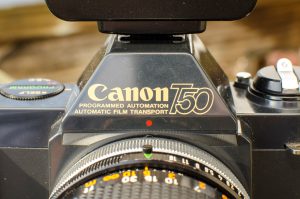
Despite these pluses, there are still plenty of cons. As I mentioned earlier, they are ugly. The whole gray plastic and bulbous battery compartment seems really poorly thought out in my opinion. Even the logo is silk-screened onto the camera using a gaudy fake-gold paint.
Another point of contention is complete lack of manual control. This camera falls into a very narrow niche of being almost completely fully automatic, but still requires the user to manually focus. Most people who like fully automatic cameras really want everything to be automatic, even the focus. And people who like manual focus usually like more control over their photos. Even if you are interested in an easy to use fully automatic camera with manual focus, there are so many better options out there. The Canon A series, or models by Nikon, Minolta, Konica, or Pentax also offer Program modes along with some manual control and are cheap as well.
I’ll admit that the only reason I even have this camera was that I needed something else from KEH and couldn’t pass up a $1.79 camera. If you already have some Canon FD lenses and 2 bucks burning a hole in your pocket, a T50 might fulfill a creative experiment for an extra roll of film you have laying around.
My Results
I took this camera with me to my parents for Halloween and admittedly, it wasn’t an ideal environment for photography. In addition I mounted my Nikon SB-600 speed light to this camera which this camera cannot detect. It can only manually fire the flash when the shutter is released. The image above with the Canon 244T flash was not used in any of these photographs.
I feel like that’s important to know before judging these shots as I clearly did not do a good job of focusing on many of them. I used a Canon 50mm f/1.4 lens which I have gotten great results with using different bodies. With that in mind, I feel as though the auto exposure system of the T50 works quite well given the challenging lighting conditions I gave it. Many of the pictures came out nice and whatever focus issues should be blamed on me, and not the camera.
Given good film, a good lens, and ideal lighting conditions, there’s no reason a T50 couldn’t make just as nice looking photographs as any Canon, or any other SLR for that matter, in my collection.
I think the context of this review should focus (pun intended) on the usability of this camera which is very good. Sure, its an ugly looking camera, and yeah, it has absolutely no manual control, but I’m not going to sit here and act like some film elitist. There are many reasons why a fully automatic camera could be useful. It runs on common AA batteries, has an accurate metering system, and accepts many quality FD lenses. For those of you who would never consider a T50, check one out. Hell, check out a couple of them in case one doesn’t work. At $1.79, its a pretty good bargain!
Additional Resources
https://en.wikipedia.org/wiki/Canon_T50
http://casualphotophile.com/2014/05/05/canon-t50-camera-review/
http://www.mir.com.my/rb/photography/companies/canon/fdresources/SLRs/t50/
http://lewiscollard.com/cameras/canon-t50/
http://michaelraso.blogspot.com/2011/01/canon-t-50-amazing-canon-fd-slr-point.html
http://filmphotographyproject.com/content/2011/01/canon-t-50-amazing-canon-fd-slr-point-shoot-camera

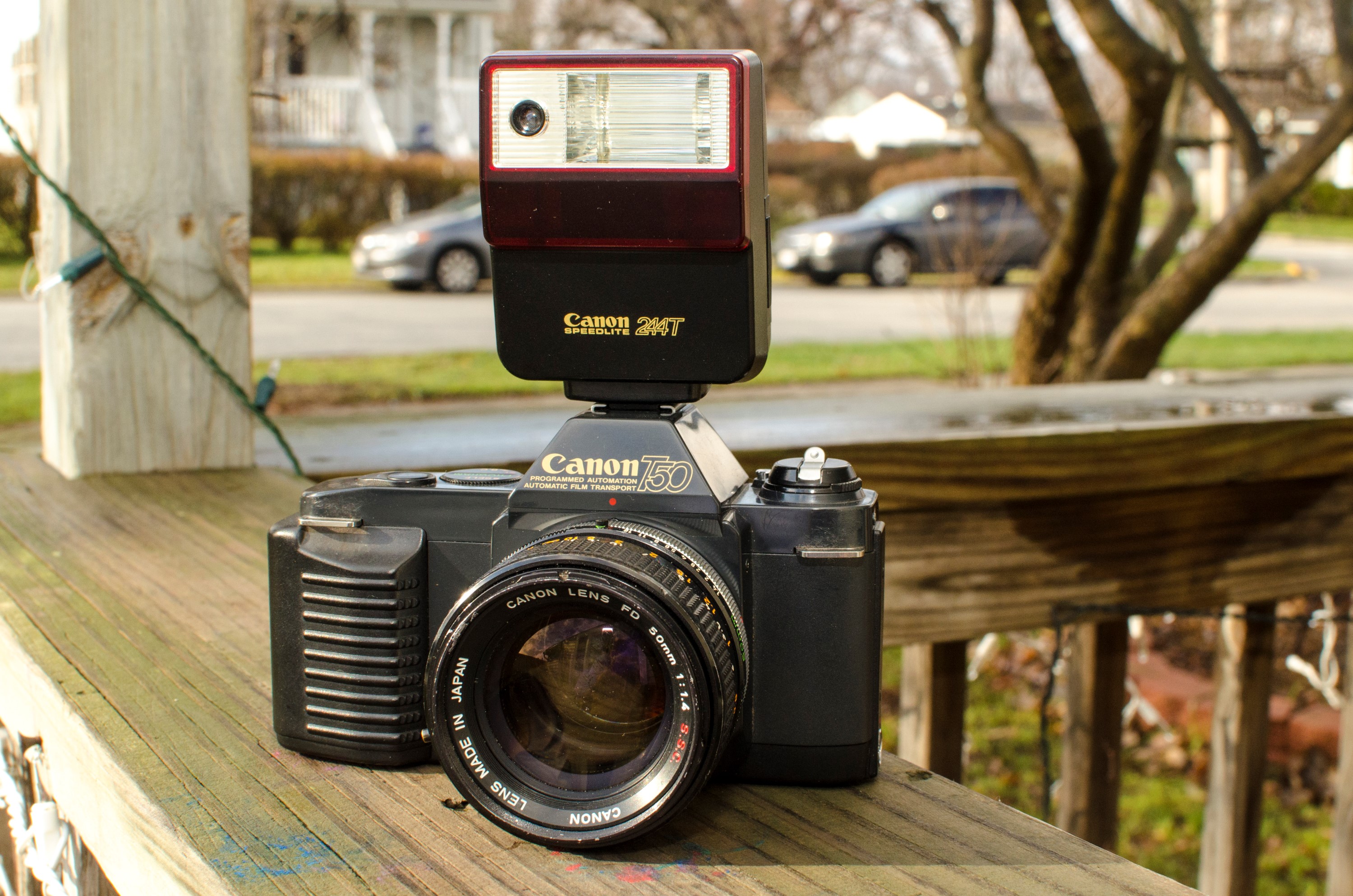
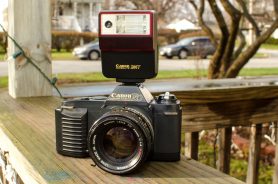
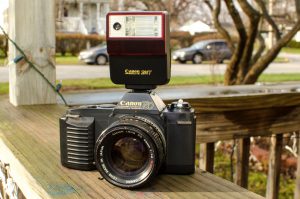








Hey there. A few days ago I found this T50 lying around in my mother’s house. I still haven’t finished my first test film roll with this camera. It seems that your photos came out nicely, given the less than ideal lighting. I’m crossing fingers for my results!
A truly ugly camera but when you hold it it fits the hand perfectly…. strange….
And the results are very good. Auto exposure works Canon like and is spot on, mostly. The T50 and it’s higher specced sibling the T70 are ugly but good cameras!
Hope one day you pick up a T90 with a TL300 for review. I fell in love with them after seeing Bruce Gilden’s flashy NY subway work. Amazing tools.
I’ve passively kept my eye out for a cheap T90, but their reputation for unreliable electronics causes me a bit of hesitation. Apparently over time some part of the metering system goes bad rendering the camera unusable. Reminds me of the electrical issues common to the Minolta X700.